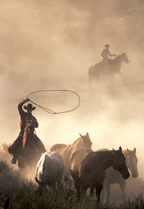

Traditions
Gaucho is a term commonly used to describe residents of the South American's Pampa, originally found on lands of Southern Brazil, Uruguay,
Argentina and Chile. In Brazil, it is also used to designate people from the state of Rio Grande do Sul. The word Gaucho might be described as an equivalent to the North American "Cowboy" or Vaquero, in Spanish.
Gauchos made up the majority of the rural population, herding cows on the vast estâncias or farms, and practicing hunting as their main economic activities.


National Pride
The Gaucho plays an important and symbolic role in the nationalist feelings of this Pampa region, the flat and plain land that extends north from Patagonia; bounded on the west by the Andes and extending on the east to Argentina, Uruguay and the Brazilian state of Rio Grande do Sul.
Residing outside of the growing urban towns and farming settlements, these skilled horse riders lived off the land often willingly sharing their food and drinking Mate tea with other travelers.
The image of the free Gaucho, a longstanding symbol of national pride is often contrasted to the slaves who worked the northern Brazilian lands.
Like the North American cowboys, Gauchos were generally reputed to be strong, honest, silent types, but proud and capable of violence when provoked.


The typical Gaucho outfit is quite different from the American cowboys and would include a "poncho" (heavy wool fabric to protect against the cold, also used as a saddle blanket and sleeping equipment too), the "bombacha" (loose pants breeches)
and the "chiripá" (chaps used to
protect the bombachas). Their working tools on the field were the "boleadoras" (three leather-bound rocks tied with leather straps about three feet long similar to the "American" balls), the "rebenque" (leather stick) and the famous and legendary "facão" (large knife) embedded in the back of the Gaucho's band, usually the only food instrument a Gaucho carried.
Finally, the Gaucho's diet was composed almost entirely of meat made in a bonfire while in the field, complemented by "Chimarrão"
referred as the Gaucho's "mate tea" and "drink of the Gods" for it's rejuvenating and invigorating nourishment. The "drink of friendship" is traditionally shared by the warm water filling the mate gourd and passing through the gathering of friends.






